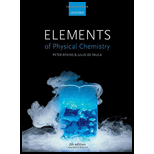
Elements Of Physical Chemistry
7th Edition
ISBN: 9780198796701
Author: ATKINS, P. W. (peter William), De Paula, Julio
Publisher: Oxford University Press
expand_more
expand_more
format_list_bulleted
Question
Chapter 1, Problem 1C.1ST
Interpretation Introduction
Interpretation:
The compression factor conditions and molar volume of the gas has to be calculated and dominatinginteraction has to be given.
Concept Introduction:
Compression factor:
Compression factorgiven by,
Expert Solution & Answer
Want to see the full answer?
Check out a sample textbook solution
Students have asked these similar questions
What is the final product when hexanedioic acid reacts with 1º PCl5 and 2º NH3.
What is the final product when D-galactose reacts with hydroxylamine?
Indicate the formula of the product obtained by reacting methyl 5-chloro-5-oxopentanoate with 1 mole of 4-penten-1-ylmagnesium bromide.
Chapter 1 Solutions
Elements Of Physical Chemistry
Ch. 1 - Prob. 1A.1STCh. 1 - Prob. 1A.2STCh. 1 - Prob. 1A.3STCh. 1 - Prob. 1A.4STCh. 1 - Prob. 1B.1STCh. 1 - Prob. 1B.2STCh. 1 - Prob. 1B.3STCh. 1 - Prob. 1B.4STCh. 1 - Prob. 1B.5STCh. 1 - Prob. 1C.1ST
Ch. 1 - Prob. 1C.2STCh. 1 - Prob. 1A.1ECh. 1 - Prob. 1A.2ECh. 1 - Prob. 1A.3ECh. 1 - Prob. 1A.4ECh. 1 - Prob. 1A.5ECh. 1 - Prob. 1A.6ECh. 1 - Prob. 1A.7ECh. 1 - Prob. 1A.8ECh. 1 - Prob. 1A.9ECh. 1 - Prob. 1A.10ECh. 1 - Prob. 1A.11ECh. 1 - Prob. 1A.12ECh. 1 - Prob. 1A.13ECh. 1 - Prob. 1A.14ECh. 1 - Prob. 1B.1ECh. 1 - Prob. 1B.2ECh. 1 - Prob. 1B.3ECh. 1 - Prob. 1B.4ECh. 1 - Prob. 1B.5ECh. 1 - Prob. 1B.6ECh. 1 - Prob. 1B.7ECh. 1 - Prob. 1B.8ECh. 1 - Prob. 1C.1ECh. 1 - Prob. 1C.2ECh. 1 - Prob. 1C.3ECh. 1 - Prob. 1C.4ECh. 1 - Prob. 1C.5ECh. 1 - Prob. 1C.6ECh. 1 - Prob. 1C.7ECh. 1 - Prob. 1C.8ECh. 1 - Prob. 1C.9ECh. 1 - Prob. 1.1DQCh. 1 - Prob. 1.2DQCh. 1 - Prob. 1.3DQCh. 1 - Prob. 1.4DQCh. 1 - Prob. 1.5DQCh. 1 - Prob. 1.6DQCh. 1 - Prob. 1.7DQCh. 1 - Prob. 1.3PCh. 1 - Prob. 1.4PCh. 1 - Prob. 1.5PCh. 1 - Prob. 1.6PCh. 1 - Prob. 1.7PCh. 1 - Prob. 1.8PCh. 1 - Prob. 1.9PCh. 1 - Prob. 1.10PCh. 1 - Prob. 1.11PCh. 1 - Prob. 1.12PCh. 1 - Prob. 1.13PCh. 1 - Prob. 1.14PCh. 1 - Prob. 1.1PRCh. 1 - Prob. 1.2PRCh. 1 - Prob. 1.3PRCh. 1 - Prob. 1.4PR
Knowledge Booster
Learn more about
Need a deep-dive on the concept behind this application? Look no further. Learn more about this topic, chemistry and related others by exploring similar questions and additional content below.Similar questions
- The temperature on a sample of pure X held at 1.25 atm and -54. °C is increased until the sample boils. The temperature is then held constant and the pressure is decreased by 0.42 atm. On the phase diagram below draw a path that shows this set of changes. pressure (atm) 2 0 0 200 400 temperature (K) Xarrow_forwardQUESTION: Answer Question 5: 'Calculating standard error of regression' STEP 1 by filling in all the empty green boxes *The values are all provided in the photo attached*arrow_forwardpressure (atm) 3 The pressure on a sample of pure X held at 47. °C and 0.88 atm is increased until the sample condenses. The pressure is then held constant and the temperature is decreased by 82. °C. On the phase diagram below draw a path that shows this set of changes. 0 0 200 temperature (K) 400 аarrow_forward
- er your payment details | bar xb Home | bartleby x + aleksogi/x/isl.exe/1o u-lgNskr7j8P3jH-1Qs_pBanHhviTCeeBZbufuBYT0Hz7m7D3ZcW81NC1d8Kzb4srFik1OUFhKMUXzhGpw7k1 O States of Matter Sketching a described thermodynamic change on a phase diagram 0/5 The pressure on a sample of pure X held at 47. °C and 0.88 atm is increased until the sample condenses. The pressure is then held constant and the temperature is decreased by 82. °C. On the phase diagram below draw a path that shows this set of changes. pressure (atm) 1 3- 0- 0 200 Explanation Check temperature (K) 400 X Q Search L G 2025 McGraw Hill LLC. All Rights Reserved Terms of Use Privacy Cearrow_forward5.arrow_forward6.arrow_forward
arrow_back_ios
SEE MORE QUESTIONS
arrow_forward_ios
Recommended textbooks for you
 ChemistryChemistryISBN:9781305957404Author:Steven S. Zumdahl, Susan A. Zumdahl, Donald J. DeCostePublisher:Cengage Learning
ChemistryChemistryISBN:9781305957404Author:Steven S. Zumdahl, Susan A. Zumdahl, Donald J. DeCostePublisher:Cengage Learning ChemistryChemistryISBN:9781259911156Author:Raymond Chang Dr., Jason Overby ProfessorPublisher:McGraw-Hill Education
ChemistryChemistryISBN:9781259911156Author:Raymond Chang Dr., Jason Overby ProfessorPublisher:McGraw-Hill Education Principles of Instrumental AnalysisChemistryISBN:9781305577213Author:Douglas A. Skoog, F. James Holler, Stanley R. CrouchPublisher:Cengage Learning
Principles of Instrumental AnalysisChemistryISBN:9781305577213Author:Douglas A. Skoog, F. James Holler, Stanley R. CrouchPublisher:Cengage Learning Organic ChemistryChemistryISBN:9780078021558Author:Janice Gorzynski Smith Dr.Publisher:McGraw-Hill Education
Organic ChemistryChemistryISBN:9780078021558Author:Janice Gorzynski Smith Dr.Publisher:McGraw-Hill Education Chemistry: Principles and ReactionsChemistryISBN:9781305079373Author:William L. Masterton, Cecile N. HurleyPublisher:Cengage Learning
Chemistry: Principles and ReactionsChemistryISBN:9781305079373Author:William L. Masterton, Cecile N. HurleyPublisher:Cengage Learning Elementary Principles of Chemical Processes, Bind...ChemistryISBN:9781118431221Author:Richard M. Felder, Ronald W. Rousseau, Lisa G. BullardPublisher:WILEY
Elementary Principles of Chemical Processes, Bind...ChemistryISBN:9781118431221Author:Richard M. Felder, Ronald W. Rousseau, Lisa G. BullardPublisher:WILEY

Chemistry
Chemistry
ISBN:9781305957404
Author:Steven S. Zumdahl, Susan A. Zumdahl, Donald J. DeCoste
Publisher:Cengage Learning

Chemistry
Chemistry
ISBN:9781259911156
Author:Raymond Chang Dr., Jason Overby Professor
Publisher:McGraw-Hill Education

Principles of Instrumental Analysis
Chemistry
ISBN:9781305577213
Author:Douglas A. Skoog, F. James Holler, Stanley R. Crouch
Publisher:Cengage Learning

Organic Chemistry
Chemistry
ISBN:9780078021558
Author:Janice Gorzynski Smith Dr.
Publisher:McGraw-Hill Education

Chemistry: Principles and Reactions
Chemistry
ISBN:9781305079373
Author:William L. Masterton, Cecile N. Hurley
Publisher:Cengage Learning

Elementary Principles of Chemical Processes, Bind...
Chemistry
ISBN:9781118431221
Author:Richard M. Felder, Ronald W. Rousseau, Lisa G. Bullard
Publisher:WILEY
DISTINCTION BETWEEN ADSORPTION AND ABSORPTION; Author: 7activestudio;https://www.youtube.com/watch?v=vbWRuSk-BhE;License: Standard YouTube License, CC-BY
Difference Between Absorption and Adsorption - Surface Chemistry - Chemistry Class 11; Author: Ekeeda;https://www.youtube.com/watch?v=e7Ql2ZElgc0;License: Standard Youtube License